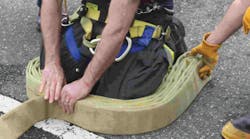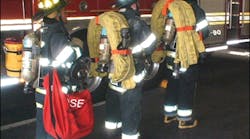We have covered a lot of ground as it relates to hose-pack systems in the first two parts of this series. We now know that it’s not as simple as throwing 150 feet of 1 1/2-inch hose with a 95 gallon per minute (gpm) fog nozzle in a bag and then on top of the apparatus. We went over the basic principles, including how to divide up the equipment, what these items are used for and how to get the needed items to the floor below the fire. Now, in this final article, we’ll talk about fire attack and how to deploy the system. This system does offer flexibility of either 2 1/2-inch hose with a 1 1/4-inch tip (325 gpm) or 1 3/4-inch hose with a 15/16-inch tip (185 gpm). The use of the 1 3/4-inch is only a single length stretched off the 2 1/2-inch break-apart nozzle. The 1 3/4-inch is a tool and is not a must-use resource. Remember, high-rise and standpipe operations are fraught with many hidden dangers that can affect water supply and fire attack ability. The 1 3/4-inch hose is for specific situations that have been spelled out previously.
Regardless of what strategy you choose to use, make sure your people are well trained and understand the theories and principles. Practical training is very important, but so is the academic training because this explains the reasons why we do certain things. Firefighters have to be able to grasp the principles and theories and be more than just “drones.” If you teach them properly, they then become an extra set of eyes and ears for you as the company officer or incident commander (IC). This is critical to reducing firefighter injuries and deaths.
The Attack Line
When the system is brought into a fire in a standpipe-equipped building, such as a residential high rise, prudent practices demand that the initial attack line be hooked up on the floor below the fire. This allows members to operate in an area of refuge or safety, free from the products of combustion.
Anytime we operate with uncharged hoselines, it should be in an area that is not prone to any extreme form of fire behavior. This could include one of three areas in our typical residential high-rise buildings. For example:
The stretch to the apartment door – The easiest stretch involves when the fire apartment door is closed. The door is of the fire-rated type and the doorframe and walls are also intact, keeping the fire compartmentalized. The line is stretched dry to the apartment door so that a 50-foot length of hose is ready to advance when the line is charged and the door forced open. Whether the stretch is a 2 1/2-inch handline or the 1 3/4-inch length attached to the end of the 2 1/2-inch nozzle (see Photo 1), the principle remains the same; 50 feet of hose is stretched in front of the apartment door (see Photo 2). The line is then charged, the nozzle checked for adequate pressure and flow, and then the door is forced. The members hit the ceiling with the stream and then advance inside.
With 50-foot hose readily available, there aren’t too many apartments that can’t be reached by this length plus the 30- to 40-foot stream. If more hose is needed, then the additional members have to work as a team to advance the line further.
The stretch to the stairwell door – If the apartment door is compromised and the common hallway threatened by fire, members will then stretch the line dry in the “attack” stairwell. With this door to the public hallway closed and the “attack” stair free of smoke and other products of combustion, members can stretch a length of hose up the stairwell to the landing above the fire floor. The line is connected on the floor below the fire like previously, but we need a place to deploy extra line. For that we stretch up an additional flight of stairs prior to entering the fire floor (see Photo 3). This is a convenient means as it takes advantage of available space and allows gravity to help deploy the line. The line is charged and the stream pattern checked before this door is opened and as the line advances, the length on the stairs that was stretched a flight above deploys with the help of gravity.
Charging the line on the floor below the fire – In the unlikely event that not only is the fire apartment door open to the common hallway, but also the door to the stairwell has been compromised, the engine company has no choice but to have water in the line as they make their way up to the fire floor. Remember; don’t place yourself in a position where flashover could render you a casualty. Make sure you have water prior to moving into this dangerously dynamic and ever-changing environment!
The problem with a charged hoseline is that it requires a coordinated effort to move it to the seat of the fire and adequate staffing is a requirement. A dry hoseline allows for a very rapid stretch that doesn’t require half the staffing level, but the “kicker” is knowing when to have water and when to use the advantages of the dry line. The bottom line is to never enter a flashover-prone setting without the ability to apply water instantly and from a distance.
Staffing of the line does require the nozzle team, but the other members assigned to the stretch are equally critical. They must be placed in strategic positions and must be trained in their role prior to “the big game.” Right now, are your people ready for the “big game” or is a bit more training needed?
The Backup Line
Most of our fires are put out with the first hoseline. But a prudent fire officer knows that a backup line can act as an insurance policy for any number of reasons. The backup line is best stretched from the floor below where the attack line was hooked up. If the attack line was hooked up on the 14th floor, then the backup line can be hooked up on the 13th floor (see Photo 4).
The reason is that this offers redundancy. Departments that rely on a wye for the attack and backup line deployment can run into certain problems. The wye is from a single supply line from a single outlet. If problems were encountered at this connection, say the pressure regulating system failed miserably to provide an adequate flow, both the attack and backup line would be in jeopardy. Also, what if the line supplying the wye burst and with it went all of our water?
By hooking up to the floor below the attack line, we have some degree of redundancy. An insurance policy, if you will. The downside is this requires an additional length of hose. Both the attack line and backup line have to be flaked out and kink free for maximum flow and efficiency. Use the hallways on the floors that you chose to hookup on to flake out the hose properly (Photo 5).
Also, if we are relying on 2 1/2-inch lines (whether they are reduced down to 1 3/4-inch for the last 50 feet or not), the use of a large wye with a 2 1/2-inch inlet and 2 x 2 1/2-inch outlets weighs a great deal and is not practical in a system that strives for reduced weight. Remember that when the line goes into operation, we are going to need four to eight members to get a single 2 1/2-inch line into operation. We’ll need a nozzle firefighter and two backup firefighters to absorb the nozzle reaction, and additional members spread out to assist in the advance. In addition, a firefighter has to be at the standpipe outlet to control flow. An officer is ideally suited to be up front with the nozzle team providing guidance and direction. If the 1 3/4-inch length is used at the end instead of the larger line, we can make do with a nozzle firefighter and a single backup firefighter, but the other members on the line are critical to advancing (see Photo 6).
Summary
We covered a lot over these past three articles. Take a look at your present fireground operations as it relates to standpipe operations and see where your strengths and weaknesses are. Now is the time to correct those deficiencies.
Fires in high-rise buildings require a lot of people; given the life hazard, the need to maintain the momentum of the attack, and possibly the need for several lines, staffing is a must. Therefore, while your community may not have a high-rise or standpipe-equipped building, it would be prudent to prepare for such a mutual-aid response. Having your own hose-pack system may pay dividends for when that call is received!
ARMAND F. GUZZI JR. has been a member of the fire service since 1987. He is a career fire lieutenant with the City of Long Branch, NJ, Fire Department and is the deputy director of the Monmouth County, NJ, Fire Academy where he has taught for over 20 years. He has a masters degree in management and undergraduate degrees in fire science, education, and business administration. View all of Armand's articles here. He can be reached via e-mail at [email protected] or [email protected].








